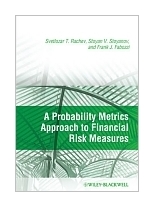|
||
• wydawnictwa polskie
• Zamów informacje o nowościach z wybranego tematu • kontakt
• Cookies na stronie |
A PROBABILITY METRICS APPROACH TO FINANCIAL RISK MEASURESRACHEV S.T. STOYANOV S.V. FABOZZI F.J.wydawnictwo: WILEY BLACKWELL , rok wydania 2011, wydanie Icena netto: net price + 5% vat. A Probability Metrics Approach to Financial Risk Measures relates the field of probability metrics and risk measures to one another and applies them to finance for the first time.
Table of Contents
Preface. About the Authors. Chapter 1 Introduction. 1.1 Probability Metrics. 1.2 Applications in Finance. Chapter 2 Probability Distances and Metrics. 2.1 Introduction. 2.2 Some Examples of Probability Metrics. 2.2.1 Engineer's metric. 2.2.2 Uniform (or Kolmogorov) metric. 2.2.3 Levy metric. 2.2.4 Kantorovich metric. 2.2.5 Lp-metrics between distribution functions. 2.2.6 Ky Fan metrics. 2.2.7 Lp-metric. 2.3 Distance and Semidistance Spaces. 2.4 Definitions of Probability Distances and Metrics. 2.5 Summary. 2.6 Technical Appendix. 2.6.1 Universally measurable separable metric spaces. 2.6.2 The equivalence of the notions of p. (semi-)distance on P2 and on X. Chapter 3 Choice Under Uncertainty. 3.1 Introduction. 3.2 Expected Utility Theory. 3.2.1 St. Petersburg Paradox. 3.2.2 The von Neumann-Morgenstern expected utility theory. 3.2.3 Types of utility functions. 3.3 Stochastic Dominance. 3.3.1 First-order stochastic dominance. 3.3.2 Second-order stochastic dominance. 3.3.3 Rothschild-Stiglitz stochastic dominance. 3.3.4 Third-order stochastic dominance. 3.3.5 Efficient sets and the portfolio choice problem. 3.3.6 Return versus payoff. 3.4 Probability Metrics and Stochastic Dominance. 3.5 Cumulative Prospect Theory. 3.6 Summary. 3.7 Technical Appendix. 3.7.1 The axioms of choice. 3.7.2 Stochastic dominance relations of order n. 3.7.3 Return versus payoff and stochastic dominance. 3.7.4 Other stochastic dominance relations. Chapter 4 A Classification of Probability Distances. 4.1 Introduction. 4.2 Primary Distances and Primary Metrics. 4.3 Simple Distances and Metrics. 4.4 Compound Distances and Moment Functions. 4.5 Ideal Probability Metrics. 4.5.1 Interpretation and examples of ideal probability metrics. 4.5.2 Conditions for boundedness of ideal probability metrics. 4.6 Summary. 4.7 Technical Appendix. 4.7.1 Examples of primary distances. 4.7.2 Examples of simple distances. 4.7.3 Examples of compound distances. 4.7.4 Examples of moment functions. Chapter 5 Risk and Uncertainty. 5.1 Introduction. 5.2 Measures of Dispersion. 5.2.1 Standard deviation. 5.2.2 Mean absolute deviation. 5.2.3 Semi-standard deviation. 5.2.4 Axiomatic description. 5.2.5 Deviation measures. 5.3 Probability Metrics and Dispersion Measures. 5.4 Measures of Risk. 5.4.1 Value-at-risk. 5.4.2 Computing portfolio VaR in practice. 5.4.3 Back-testing of VaR. 5.4.4 Coherent risk measures. 5.5 Risk Measures and Dispersion Measures. 5.6 Risk Measures and Stochastic Orders. 5.7 Summary. 5.8 Technical Appendix. 5.8.1 Convex risk measures. 5.8.2 Probability metrics and deviation measures. 5.8.3 Deviation measures and probability quasi-metrics. Chapter 6 Average Value-at-Risk. 6.1 Introduction. 6.2 Average Value-at-Risk. 6.2.1 AVaR for stable distributions. 6.3 AVaR Estimation From a Sample. 6.4 Computing Portfolio AVaR in Practice. 6.4.1 The multivariate normal assumption. 6.4.2 The Historical Method. 6.4.3 The Hybrid Method. 6.4.4 The Monte Carlo Method. 6.4.5 Kernel methods. 6.5 Back-testing of AVaR. 6.6 Spectral Risk Measures. 6.7 Risk Measures and Probability Metrics. 6.8 Risk Measures Based on Distortion Functionals. 6.9 Summary. 6.10 Technical Appendix. 6.10.1 Characteristics of conditional loss distributions. 6.10.2 Higher-order AVaR. 6.10.3 The minimization formula for AVaR. 6.10.4 ETL vs AVaR. 6.10.5 Kernel-based estimation of AVaR. 6.10.6 Remarks on spectral risk measures. Chapter 7 Computing AVaR through Monte Carlo. 7.1 Introduction. 7.2 An illustration of Monte Carlo Variability. 7.3 Asymptotic Distribution, Classical Conditions. 7.4 Rate of Convergence to the Normal Distribution. 7.4.1 The effect of tail thickness. 7.4.2 The effect of tail truncation. 7.4.3 Infinite variance distributions. 7.5 Asymptotic Distribution, Heavy-tailed Returns. 7.6 Rate of Convergence, Heavy-tailed Returns. 7.6.1 Stable Paretian distributions. 7.6.2 Student's t distribution. 7.7 On the choice of a distributional model. 7.7.1 Tail behavior and return frequency. 7.7.2 Practical implications. 7.8 Summary. 7.9 Technical Appendix. 7.9.1 Proof of the stable limit result. Chapter 8 Stochastic Dominance Revisited. 8.1 Introduction. 8.2 Metrization of Preference Relations. 8.3 The Hausdorff Metric Structure. 8.4 Examples. 8.4.1 The Levy quasi-semidistance and first-order stochastic dominance. 8.4.2 Higher order stochastic dominance. 8.4.3 The H-quasi-semidistance. 8.4.4 AVaR generated stochastic orders. 8.4.5 Compound quasi-semidistances. 8.5 Utility-type Representations. 8.6 Almost Sstochastic Orders and Degree of Violation. 8.7 Summary. 8.8 Technical Appendix. 8.8.1 Preference relations and topology. 8.8.2 Quasi-semidistances and preference relations. 8.8.3 Construction of quasi-semidistances on classes of investors. 8.8.4 Investors with balanced views. 8.8.5 Structural classification of probability distances. Index. 392 pages, Hardcover Księgarnia nie działa. Nie odpowiadamy na pytania i nie realizujemy zamówien. Do odwolania !. |


